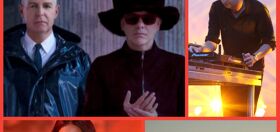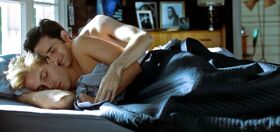 In an effort to debunk the validity of gaydar, researchers at the University of Wisconsin-Madison conducted a study where they challenged the “gaydar myth” according to a report on the University’s news website. The findings, which were published in the Journal of Sex Research, conclude that gaydar isn’t real. Try telling that to gay men everywhere.
In an effort to debunk the validity of gaydar, researchers at the University of Wisconsin-Madison conducted a study where they challenged the “gaydar myth” according to a report on the University’s news website. The findings, which were published in the Journal of Sex Research, conclude that gaydar isn’t real. Try telling that to gay men everywhere.
William Cox, an assistant scientist at the University’s Department of Psychology who was also the lead author of the study, feels gaydar is less about being able to determine a person’s sexual orientation and more about engaging in harmful forms of stereotyping. “Most people think of stereotyping as inappropriate,” stated Cox. “But if you’re not calling it ‘stereotyping,’ if you’re giving it this other label and camouflaging it as ‘gaydar,’ it appears to be more socially and personally acceptable.”
Cox and his team conducted a series of studies, one of which consisted of manipulating their subjects’ understanding of the term “gaydar.” Three groups of people were given different explanations — one group was told gaydar was real, another was told it was a way of stereotyping and the third group was given no definition. The end result? The group that was told gaydar is real engaged in more stereotyping by assuming men were gay based off of certain cues. For example, if the group was told a particular man liked to go shopping, they felt they were utilizing their gaydar in the assumption that he was gay.
 Cox believes, “If you tell people they have gaydar, it legitimizes the use of those stereotypes.”
Cox believes, “If you tell people they have gaydar, it legitimizes the use of those stereotypes.”
How about we take this to the next level?
Our newsletter is like a refreshing cocktail (or mocktail) of LGBTQ+ entertainment and pop culture, served up with a side of eye-candy.
Good thing they didn’t tell the group the guy liked to get mani-pedis after attending bottomless mimosa brunches. Their gaydars might have gone into circuit overload.
Cox also has a fascinating theory about men who are assumed to be gay if they wear pink shirts and it’s tied into the fact that a small percentage of the population is gay.
“Imagine that 100 percent of gay men wear pink shirts all the time, and 10 percent of straight men wear pink shirts all the time. Even though all gay men wear pink shirts, there would still be twice as many straight men wearing pink shirts. So, even in this extreme example, people who rely on pink shirts as a stereotypic cue to assume men are gay will be wrong two-thirds of the time.”
Umm, did we wake up this morning and get transported back to 1998?
 Cox’s research conflicts with a 2008 report that concluded people could accurately guess sexual orientation based on photographs of people’s faces. That study somehow gave the existence of gaydar some validity within the scientific realm.
Cox’s research conflicts with a 2008 report that concluded people could accurately guess sexual orientation based on photographs of people’s faces. That study somehow gave the existence of gaydar some validity within the scientific realm.
While Cox and his team of researchers are clearly well intentioned in trying to highlight the existence of prejudice through stereotyping, there is a major design flaw with studies on gaydar that has been overlooked. Gaydar is similar to the “Force” from the Star Wars movies. Just like the Force is always strongest among Jedis, gaydar works the same way for us gays. Similar to the Jedi that trains to use the Force to his advantage, we fine-tune it over time through our life experiences. Way before Grindr (aka the prehistoric times), gaydar is what we relied on to determine how many other gay men were X amount of feet away. It was, and still is, very beneficially for expanding our social circles whether it be meeting new friends or cruising in public. The signals we receive from our gaydars are how we know it’s safe to continue to engage. Take it from a guy who has done the legwork. Gaydar is real.
Gaydar is a feeling. It’s based on a vibe a man gets from another man. It’s about eye contact and body language. It takes face-to-face personal interaction and cannot be acquired by looking at photos of other men in an effort to figure out if they are of the homosexual persuasion. Therein lies a huge difference. Judging one’s appearance from a photograph or based on second-hand information about how he acts is stereotyping. Getting a phone number from a cute guy at Starbucks…that’s gaydar.
Great strides have been made in equality and the quest continues, but when it comes to gaydar, this is one of those times where we have to be separatists and say, “It’s a gay thing.”
We want to hear from our readers. What have your experiences been like when it comes to gaydar? Share your stories in the comments section.




















Liam Barnes
I think people need to stop latching on to these “New Study Finds” so seriously. A single study’s results are meaningless. It takes multiple repeats of said study to verify if it has any merits. How about we wait until the headline is “Multiple studies find?”
Alex Banx
gaydar doesn’t exist because it would require all people to be 100% honest with themselves and aware of themselves. obvs.
closted-cases and those who just haven’t figured it out yet and my never will always exist. duh.
Brian JC Kneeland
If you want an outcome you can find a study that supports it somewhere – but that proves nothing, really!
John Veauthier
Let’s just call “gaydar”what it really is. Homophobic stereotyping. It’s not some special sixth sense that some people are blessed to possess. It’s old and tired.
Brian Tacovelli
That is preposterous!
Mykaels
They did a study about stereotypes, not gaydar. Gaydar is about understanding the nuances of someone to know their sexuality, not “spotting obvious traits”. It’s one of those things I know I have (a really good one too) but cannot quite describe it.
Dag Espen Thygesen
Gaydar sometimes is just wishful thinking
Keith Ryli McDonald
There’s one problem with this study. When I see a guy that doesn’t fit any gay stereotypes and still I say, “yep, he’s gay.”
Bauhaus
“Gaydar is a feeling. It’s based on a vibe a man gets from another man. It’s about eye contact and body language.”
Exactly.
About stereotypes – Marcus Bachman and Lindsay Graham. Enough said.
About me – well, I do have a fair amount of pink in my wardrobe.
Bob LaBlah
That picture on the front page with two obvious black boxers staring each other down is just as tacky as Andrew Christians inability to find at least ONE black person to tell about the horrors of things that happened to them when they realized they were gay and told others (June of this year about two weeks before the gay pride parades across the world).
Charles Begley
hot guys !
Greg Marmai
Wait…. Enough people actually believe in “gaydar” to conduct a study?
PRINCE OF SNARKNESS aka DIVKID
There’s effeminate-dar and that’s it.
AtticusBennett
there are gay men who believe that “nobody can tell they’re gay” – they’re wrong. savvy people can tell. the more you’re OUT, and the more you interact with gay people the more you realize it’s not about stereotypes at all. it’s much more nuanced.
family can spot family. it’s often easier to spot a closeted gay man than a comfortable openly-gay one; the giveaways are obvious to anyone who’s left the Closet far behind.
Sluggo2007
I find it hysterical that the lead scientist on this study is named Cox.
Jacqueline Paul
BULLSHIT.
Jacqueline Paul
John..i disagree..i can spot from 50 paces.
Desert Boy
There is a vibe, a quiet knowing, when gay men (can’t speak for lesbians) see or have contact with another gay man. Sometimes, overt like a smile, or a wink. But, other times, it’s quite mystical. My Gaydar is usually spot-on. Sometimes, I just don’t feel it, but for the most part, I can tell if a man is gay or not.
Desert Boy
@Sluggo2007: I missed it! HAHAHAHAHAHAHAHA!
Captain Obvious
Oh please. A few years ago this hot(and taken) guy started flirting with me out of the blue because he could tell I was gay just by watching me walk into the room. I fit no stereotypes whatsoever, straight people can never tell unless they happen to see me checking out a guy.
Gay men can tell, especially if they’re originally from a very closeted area.
Fact of the matter is most people who aren’t gay don’t know what the hell gaydar actually is or what to look for. They think it doesn’t exist because they don’t need to hone something like that.
We do it as a survival mechanism because without assessing the situation you actually could put yourself in a lot of danger assuming someone is gay when they aren’t. We NEED gaydar, straight people don’t. So I don’t really care what they think about the topic.
Gay people who don’t think gaydar exists also amuse me because they’ve been so privileged to live in an area where most people are out that they never needed to hone such a skill and therefore also have no clue what they’re talking about.
Honestly it’s not even that big a deal. We learned to tell who’s gay and who isn’t so we don’t get punched in the face. It’s not a party trick or a guessing game.
It’s hard to even explain what we’re looking for because there are so many minute details that make up “gaydar” that no one who doesn’t have a need for it would even bother to notice. It can be anything from your face to the way you talk with your hands… but it’s NEVER wrong. Always worked for me and many others.
A lot better than waiting around for the guy with “I’m gay!” tattooed on his forehead.
PRINCE OF SNARKNESS aka DIVKID
The people convinced that all gay men — ALL GAY MEN! — ALL gay men who have ever existed — ALL gay men, notwithstanding widely disparate temperaments and cultural expressions — ALL gay men regardless of individual genetic and phenotypical variations in the species at large …ALL.. *ALL* …*ALL*!!!..that ALL gay men are indisputably “clockable”…
…are anti-rationalist essentialist loons in the traditional of phrenologists, probably tend towards astrology and other mystical woo; and/or batshit egotistical loons believing themselves so irresistible that no gay man could conceivably fail to send out a signal in the UNBELIEVABLY hot presence
Tracy Pope
@John Veauthier: Please be more creative because this — “It’s old and tired” is, well, old and tired. It’s also a good example of a “tell” or gaydar. Does any straight man use that term?
dmanhart
@John Veauthier: 51 year old gay man here. Just from your picture I would know you are gay. Sorry.. I kinda get offended when people know I am gay when they first meet me. My friends laugh their ass off anytime I try to assert I don’t look gay.
But as for gaydar.. It was a real thing when I was your age. When everyone had to stifle who they were in order to keep a job. Or not get beaten, which was fairly common at that time.
Gaydar was about having a subtle “tell”, which only other people who were gay caught. It wasn’t about identifying Liberace or Paul Lynn.
These days, when it is free for a gay man to be unstereotypical, and just be himself, you can’t tell any longer. Especially since straight guys try to look more “gay”. Nicely groomed etc.
I loathe dance music. Back in the 1980s I loathed disco. Pink Floyd, the Eagles, Tina Turner was my music. And I scorned a couple times for not being gay. In a gay bar! (thus my confusion when everyone I know says I am “obvious”).
Reminds me of that scene on Will & Grace. When Jack asked Grace if she knew he was gay when she first met him.
She said, “Jesus Christ, my DOG knew you were gay.”
AtticusBennett
ok, those of you who insist that you’re indistinguishable from a straight guy – show us yourself. pics. instagram. youtube. you know. just to prove it 😀
some guys think that since they’re not “jack” from Will & Grace then somehow they’re “not visibly gay”. they’re wrong.
any savvy person who spends enough time with different groups and types of gay men knows how to spot other gay men.
it’s not difficult. this is not to say that all gay men are the same, in any way. we’re all different. and yet within those differences lies that blue streak of recognition.
and i’ll say it again, it’s often easier to spot a closeted homosexual than a comfortably Out one.
PRINCE OF SNARKNESS aka DIVKID
No failure rate re these wondrous infallible devices, apparently
Guy068
I’ve always thought gaydar, like woman’s intuition, is just your subconscious picking up on cues and a variety of tells your conscious doesn’t pick up on and sending the result up to your conscious without showing its work…
Timothy Herbert
…
…
so they’re suggesting micro-expressions don’t exist? Or are they suggesting we are too blind to see them?
enlightenone
“Gaydar” IS an evolutionary survival tool given that homosexuals historically have been mostly “closeted” for necessary reasons.
Gordon S. Hale
Straight but Queer…. ð???
Carla White
Have you nothing better to do than this?
SFHarry
@Alex Banx: You don’t have to be honest with yourself to give off the gay vibe necessary for others to pick it up. Gaydar is a group of subtle eye and body movements that other gays can pick up because they are looking for those cues to establish contact. Where I notice a man looking at me directly in the eyes for an instant longer others would not.
loren_1955
If gaydar does not exist, then neither does the capacity for a Mormon to spot another Mormon or the same for many other groups. We learn the subtle ways of each other to be able to find each other. A human nature thing. Article and study is bogus.
Billy Budd
@Mykaels: I agree with you. The study is about stereotypes, not gaydar.
darkanser
This study seems to be exploring whether gaydar exists in STRAIGHT people. I actually had a straight friend who claimed HIS gaydar was quite accurate It begs the question if something like gaydar doesn’t exists how did gay people find each other when it was even more dangerous to be out!! It’s like asking if intuition exists. In my early days of extreme denial about myself, I had intuitions about numerous acquaintances and fellow college classmates — of their being gay. I used to scoff at all of them. Then after accepting myself, I was to find out that nearly ALL of my intuitions were correct. My gaydar actually underestimated the actual number. There were a few friends I missed entirely. It’s more of an interpersonal, dynamic, behavioral sense — not deciding if whether wearing a pink shirt makes one gay.
moldisdelicious
Gaydar is just projection and/or wishful thinking.
Bauhaus
@moldisdelicious:
What about recognition?
SonOfKings
Yes, gaydar is real. It not only exists, it swims all through us and among us, like invisible tentacles. My gaydar is so sensitive, I’ll sometimes pick up an unspoken cue from one gay man that he’s spotted another gay man that I can’t even see yet, coming around a blind corner. I am constanly finding out that men I had a “feeling” about 10 or 20 years ago have just recently come out. I’m never wrong about these things. If you’re gay and you don’t think we know who you are, you are fooling yourself. You have been spotted, booked, and clocked! No secrets among us boys.
russellhm
The Wisconsin university sponsored study must be under the influence of Gov. Shit Walker, whose campaign for the Republican nomination is flailing. And he withdrew 300 million in funding for the state’s university system to give 250 million to a new stadium. Gaydar real or imagined? Does it effing matter. . .most of us who sense a kindred spirit use hunches from years of experience.
Tommy Ogletree
It doesn’t actually exist, we are just good at making observations based on experience.
tricky ricky
study is totally bogus. testing methods flawed. methinks the study was done not with an open minded attitude but with the goal to disprove gaydar. while it might not bee 100% accurate gay men most times instinctively know another gay man. a lot of it has with genetic traits most gay men share by way of facial features. it’s in the eyes. I have been studying this myself for years. I am an autistic with incredibly poor facial recognition skills. I can’t identify someone unless I know them incredibly well or if I see them in the same place all the time and then only if they are in that place. if a person works at one store and moves to the store next door I won’t recognize them. while working on that I realized that I could spot a gay person just by looking at their face. there was something innate that just told me. after I studied the faces of every person I knew was gay I realized it had to do with eye shape. it’s very subtle but a definite tell. this method might be going out though as the population becomes more mixed with groups who never married outside of their group intermingle with more and more different racial and ethnic groups thereby creating a whole new population of people with a more exotic look which includes the shape of the eyes. but, I suspect there will still be tells which will allow instant identification among gay men.
Alan David Smith
i think there were some good points in this. i have always felt that people link way to much to the gay aspect of my life. versus other factors. i became a teenager in the 80’s and i feel that was way more influential on my taste in music than my sexuality. i think that we forget. there are just as many factors. that are about religious beliefs, where you live, how old you are. etc. that may affect your attitude. i grew up in the burbs where everything was on a loop.same resturants, same stores,and so on. that has more of a impact. did they persue that?
Ciel Morgan
really? doesn’t exist? hhmmm, never has failed me yet.
PRINCE OF SNARKNESS aka DIVKID
No false positives or false negatives, gaydarists? [italic] Really? [/italic] Please research [bold] confirmation bias [/bold]
PRINCE OF SNARKNESS aka DIVKID
…While i research HTML formatting *humililated-to-the-point-of-ritual-suicide face*
PRINCE OF SNARKNESS aka DIVKID
test
Kieran Pardo
Do people seriously believe gaydars exists?
emw727
First off – GREAT article. Second: I have not read the actual paper that was published yet, though I fully intend to (and have a feeling that I will end up finding additional design and/or definitions flaws – gut feeling!). However, based on what I have read in this and other articles, it seems the PI’s not only erroneously neglected that gay males themselves may have the most accurately honed “Gaydar”s, I have serious questions as to the validity of their measurements for “gaydar”, the assumptions made, and the seeming neglect to understand basic principles of social psychology.
Example: Does telling Group A that “god exists”, Group B “god isn’t real” and group C no mention of god – then asking them to judge the holiness of religious relics prove the existence of god??
Again – I have not read the research paper, and cannot confirm what I am about to say at this point – but it seems as thought these Psychologists forgot all about the long-standing concept of SCHEMAS (the mental framework of ideas, thoughts and behaviors tailored by experience over time, which people use to organize and process new information). True, Schemas are necessary for the formation of stereotypes, and in some cases perpetuate them, but correlation does not equal causation, folks! Similarly, it seems they neglect to understand the thoroughly researched phenomenon of self-fulfilling prophecy.
I’ll withhold comments for now regarding the effects of Priming on their results, and also confirmation bias, seeing as I cannot see how their conclusions even came to be based on what they INTENDED to measure and what they used to do so…. I can say that if this school were on my list for any postgraduate work – I would currently be crossing it off my list.
Alan in IL
Interesting, but I’d want to read the actual paper. News summaries – even from the institution – leave a lot out, and I think a lot has been left out here.
And for the other side of the argument, check out http://www.thestar.com/news/gta/2014/06/24/gaydar_works_and_conservatives_have_more_of_it_says_u_of_t_researcher.html
Lemanic
Of course “Gaydar” doesn’t exist. Anyone with a modern set of mind could figure that out.
It’s however taught. Taught by our (both externally and internally) homophobic peers in what can only be described as an equivalent to the Jim Crow laws.
And as the researches said, the gaydar optimizes perpetual stereotyping on a scale that few ever could’ve imagined. It is sad though for a culture that so far only been involved in confirming prejudices and stereotypes. That’s how we got “Queer” to be synonymous with gay culture in the first place.
The “Gaydar” is eating us from the inside out and it’s not pretty to look at. Stereotyping is out of fashion and let stay that way.
UNLEARN THE GAYDAR! LEARN CONSENT & INTEGRITY INSTEAD!